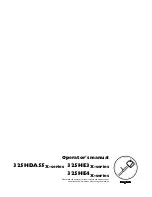
BS 400P
- 24-
5009001-00
BA-D-E-F-FL
®
or by specially instructed personnel under the
control and supervision of such electrician and in
accordance with the applicable engineering rules.
If provided for in the regulations, the power supply
to parts of machines and plants, on which
inspection, maintenance and repair work is to be
carried out must be cut off.
Before starting work, check the de-energized
parts for the presence of power and ground or
short-circuit them in addition to insulating adjacent
live parts and elements.
The electrical equipment of machines is to be
inspected and checked at regular intervals. Defects
such as loose connections or scorched cables must be
rectified immediately.
Necessary work on live parts and elements must be
carried out only in the presence of a second person
who can cut off the power supply in case of danger by
actuating the emergency shut-off or main power
switch. Secure the working area with a red-and white
safety chain and a warning sign. Use insulated tools
only.
If mobile electrical equipment, connecting cables and/
or extension/ appliance cords with plug connectors are
used, ensure that such equipment, cables and cords
are checked for correct function at least once every six
months by a qualified electrician or - if suitable testing
equipment is available - by a properly instructed
person.
Protective installations with fault-current protection
units used in non-stationary equipment must be
checked for correct operation at least once a month by
a properly instructed person.
Fault-current and fault-voltage protection units must be
checked for correct operation by actuating the testing
facility:
once on every working day in the case of mobile
equipment,
at least once every six months in the case of
stationary equipment.
3.8 Gas, dust, steam, smoke
Operate combustion engines only in well-ventilated
rooms! Before starting the unit in closed rooms, make
sure that the room is sufficiently ventilated and use the
exhaust gas hose!
Welding, burning and grinding operations on the
machine are only to be carried out if this is explicitly
authorized (there is the danger of fire and explosion)!
Before welding, burning and grinding operations clean
the machine and its surrounding area from dust and
flammable substances and care for sufficient
ventilation (danger of explosion)!
When working in confined spaces observe any existing
national regulations!
3.9 Noise
During operation sound protection devices on the
machine must be in safe position. Wear the prescribed
personal ear protection! (UVV 29 § 10, Article 29 of
the Accident Prevention regulations).
The use of noise emitting machines may be restricted
to certain times by national or local regulations.
3.10 Illumination
The machine is designed for use in daylight! The
machine operator / owner must ensure sufficient work-
place lighting for non-illuminated work sites!
3.11 Oils, greases and other chemical
substances
When handling hydraulic fluids, lubricants, greases or
preservatives (referred to hereinafter as fuels and
lubricants), the safety regulations which apply to the
respective machine are to be observed!
Avoid long contact of the fuels and lubricants with your
skin! Careful cleaning of the skin from adhering fuels
and lubricants is necessary.
Be careful when handling hot consumables (risk of
burning or scalding)
particularly at liquid temperatures
above 60°C, avoid any skin contact with these liquids!
If you get fuels or lubricants in your eyes, rinse them
immediately and carefully with potable water. Then
consult a doctor.
Remove flown out fuels and lubricants immediately!
Therefore use a binder.
Fuels and lubricants must not seep into the soil or into
the public sewage system! Fuels and lubricants which
can no longer be used are to be collected, properly
stored and to be properly disposed of.
The respective regulations and laws for handling fuels
and lubricants which are valid in the country of use are
to be observed and adhered to. This also applies to
the disposal of such fuels and lubricants. To inform
yourself turn to the responsible authorities.
3.12 Transport
Use only suitable means of transport and lifting gear of
sufficient capacity when loading or transporting the
machine! Appoint an experienced instructor for the
lifting operation!
Always observe the instructions given in the operating
manual when lifting the machine (use only the
prescribed lifting eyes for attaching the lifting gear)!
Use only suitable transport vehicles with sufficient load
capacity! Secure the load carefully. Use suitable
fastening points for securing!
















































